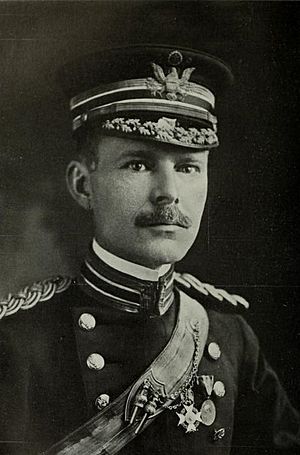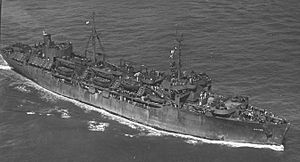George Owen Squier facts for kids
Quick facts for kids
Chief Signal Officer, U.S. Army
George Owen Squier
|
|
|---|---|

Major General George Owen Squier
|
|
| Born | March 21, 1865 Dryden, Michigan, US |
| Died | March 24, 1934 (aged 69) Washington, D.C., US |
| Buried | |
| Allegiance | |
| Service/ |
|
| Years of service | 1887–1923 |
| Rank | |
| Commands held | Chief Signal Officer |
| Battles/wars | Spanish–American War World War I |
| Awards | Distinguished Service Medal Honorary Knight Commander of the Order of St Michael and St George Order of the Crown of Italy Legion of Honor Elliott Cresson Medal John Scott Medal Franklin Medal |
| Other work | businessman, scientist |
George Owen Squier (born March 21, 1865 – died March 24, 1934) was an American soldier, scientist, and inventor. He was born in Dryden, Michigan. He studied at the United States Military Academy at West Point and later earned a Ph.D. from Johns Hopkins University. Squier was well-known in both the United States and Europe for his work. He is especially remembered for creating the company that later became known as Muzak.
Life as a Soldier and Scientist
George Squier wrote many books and articles about radio and electricity. He was also a talented inventor. In 1896, he worked with Professor Albert Cushing Crehore to create a special camera. This camera, called "The Polarizing Photo-chronograph," could measure how fast objects moved. They used it to measure the speed of bullets both inside and outside a cannon. This was an early step in using light to study fast movements.
Squier also helped develop systems for sending many telegraph messages at the same time using alternating current (AC). One of his biggest achievements was developing a way to send multiple telephone calls over a single wire in 1910. This invention, called telephone carrier multiplexing, was very important. Because of his scientific work, he was chosen to be a member of the National Academy of Sciences in 1919.
In 1907, Squier played a key role in starting the Aeronautical Division, U.S. Signal Corps. This was the very first group that would later become the United States Air Force. He also made history on September 12, 1908, by becoming the first military passenger to fly in an airplane. Working with the Wright brothers, he helped the United States Army buy its first airplanes in 1909.
From 1916 to 1917, Squier led the Aviation Section, U.S. Signal Corps. This was the next version of the Aeronautical Division. During World War I, he was promoted to major general and became the Chief Signal Officer. This meant he was in charge of all military communications.
Creating Muzak
In 1922, George Squier started a company called Wired Radio. This service sent music directly to businesses and homes through wires. In 1934, he changed the company's name to 'Muzak'.
If you ever wondered how to say his name, Squier himself said it sounds like the word square. He was also a member of the Sons of the American Revolution, a group for descendants of people who fought in the American Revolutionary War.
Death
George Owen Squier passed away in Washington, D.C., on March 24, 1934. He died from pneumonia at George Washington Hospital. He was buried at Arlington National Cemetery.
Awards and Honors
- Distinguished Service Medal (United States)
- Spanish War Service Medal (United States)
- Philippine Campaign Medal (United States)
- World War I Victory Medal (United States)
- Honorary Knight Commander of the Order of St Michael and St George (United Kingdom)
- Commander of the Legion of Honor (France)
- Commander of the Order of the Crown of Italy (Italy)
Legacy
In 1943, the United States Navy honored George Squier by naming a troopship after him. The ship was called USS General G. O. Squier (AP-130). It was the first ship of its kind, leading a class of transport ships.
Also, General Squier Memorial Park in his hometown of Dryden, Michigan, is named after him. This park is a historic place and also has a waterpark.



